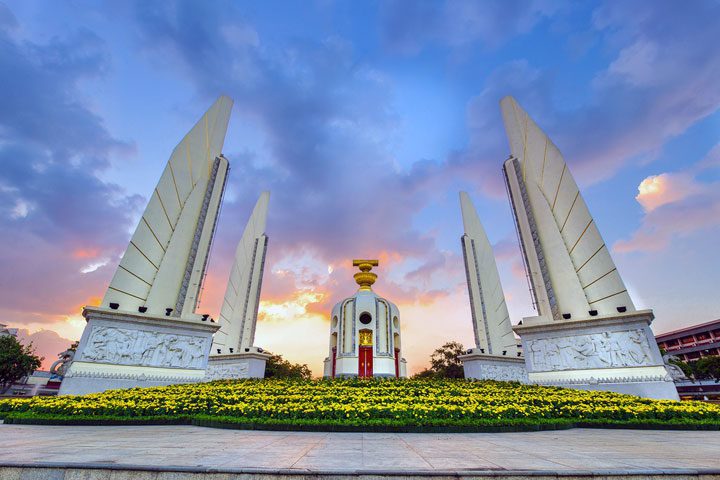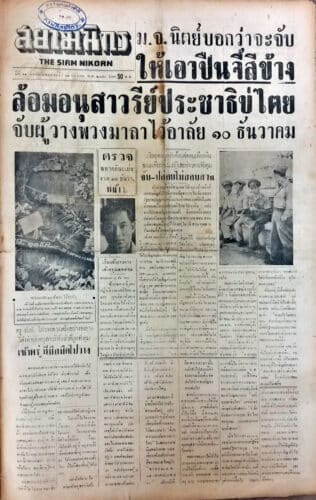How a wreath-laying was seen as an illegal act of resistance

The day after the 1947 coup, a teacher made the front page of a newspaper. It was December 10, 1947, Constitution Day, when this man came to lay a wreath at the Democracy Monument. That led to his arrest and made the front page of the Siam Nikorn (สยามนิกร, Sa-yǎam Níe-kon) newspaper. The headline read: “Man arrested for laying wreath”. Here is a short translation of this event.
That the laying of a wreath at the monument to democracy was a reason for arrest was due to the timing, as this happened a month after the military coup of November 8, 1947. This coup ended the democratic Pridi government and would eventually bring back Field Marshal Phibun help in the saddle. The influence of the People's Party (คณะราษฎร, Khá-ná Râat-sà-don) thus finally came to an end.
Some former MPs had indicated that they would protest against this undemocratic state of affairs by gathering at the Democracy Monument on Constitution Day (December 10). But the new rulers were determined to suppress this protest and had therefore prepared police and military personnel to make arrests. When the police arrived at the monument that morning, a single funeral wreath was already there. The ribbon read “To the sorrow of the Thai people – Born: December 10, 1932 – Ended: November 8, 1947”.
This tarnished the image of the authorities and they then brought in more men, determined to arrest the MPs who were coming. When the morning was already drawing to a close, however, not a single demonstrator had been spotted. That only changed when at 10 a.m. a single unknown person with a rather provisional funeral wreath approached the monument. That stranger was teacher Kaew Phromsakun (แก้ว พรหมสกุล) and his wreath read “For absolute democracy”. After Kaew had silently paid his respects for a minute, he was arrested with a grand display of force, although the police could not say on what grounds this arrest took place. Agents were simply ordered to arrest anyone who came to lay a wreath.

The front page of Siam Nikorn, the 11 December 2490[1947] issue. (Photo: sanamratsadon.org)
Wreath-laying motivation
Military: Why did you lay a wreath?
Kaew: For absolute democracy
Kaew Phromsakun, the wreath-layer at the Democracy Monument on December 10, who was arrested by authorities and detained at the Ministry of Defense on “resistance” charges, has been released after questioning by authorities. During his time in detention, Kaew Phromsakun acquired another name for himself: “Hero”. The soldiers at the ministry called him that instead of calling Kaew by his name. This because Kaew was the only one who had come to lay a wreath on that particular December 10th, no other person went there to lay a wreath as had been loudly announced beforehand.
Kaew's interrogation took place under the direction of a lieutenant colonel and a police captain. The interrogation lasted two hours, from 10 a.m. to 12 p.m. The detainee stated that he had no idea what the charge was until his eye fell on a piece of paper on which he saw the word “resistance”. Thus he learned that the laying of the wreath that day had been an act of [illegal] defiance.
The interrogator asked what time Kaew had learned of the coup. Kaew replied that he learned about this at 8 a.m. in a coffee shop on the day of the coup. The interrogator asked what Kaew's feelings were about the coup. After a moment's hesitation, Kaew replied, "I think it's bold and violent."
The questioning continued: “What do you mean by violent? Do you mean bloodshed?" Kaew replied, "No, I mean, it troubles people's hearts and minds." The interrogator replied, "Are you able to read the hearts and minds of all people like that?" Kaew replied, "Not from everyone, but I get it from the papers."
The interrogation then came to the point of whether Kaew was content with the coup. Kaew replied that he was indifferent. The interrogator asked the question, "That means you're not satisfied, isn't it?" Kaew replied, "I haven't decided anything yet because I don't know who to side with."
When the interrogator asked what Kaew wanted to achieve by laying a wreath, the answer was that he had come to demand absolute democracy. This was followed by the question: “What is absolute democracy according to you?” Kaew replied, "The power of the people." Then the question, “Why are you doing it this way (laying a wreath)?” The answer: “Because I respect democracy.”
About the new constitution, the interrogator asked if Kaew had read it. The answer: “Yes”. Then the question: “With which clause are you not satisfied?” The answer: “There are several. The 35-year age clause, for example”. [Note: In early December 1947, the Constitutional Commission discussed a resolution on lowering the minimum age for election candidates from 35 to 25.]
The wreath-laying ceremony on December 10, which led to the arrest of Kaew Phromsakun, followed the much publicized news in the newspapers that a group of MPs would turn up to lay a wreath. Kaew said he read news on the 9th. When he awoke at 5 a.m., he was sitting up in the sharp cold, unable to decide where to head for that day, the 10th.
The chill in the air reminded him that there would be a wreath-laying ceremony. Kaew thought it would be a fun idea to join. Since he was going to watch people lay wreaths anyway, it would only be appropriate to bring one himself. So Kaew Phromsakun sprang to his feet, fumbled with a rusty knife, and used it to get some branches of Bauhinias and Bougainvilleas from his backyard. By the time the rusty blade cut off the Bauhinia branches, all the flowers had already fallen off. He glued the flowers to bent twigs and intertwined them together to make a garland so fleetingly.
Kaew said he disagreed with those planning to bring black wreaths. “They go for black, we should go for red,” said Kaew, then gave the reason: “a black wreath would mean that power is already dead, but it is not dead. We have to bring red into play.” Even with the red wreath, Kaew was arrested anyway.
Before his release, Kaew said he was in the middle of a dream. When a soldier woke him up and told him they were letting him go, he was happy.
Sources:


Uniforms have long toes, Rob V, and they still do today. Strange that they tackle such a playful action with this display of power, but yes, uniforms cannot be otherwise. Just look at what is happening elsewhere in Europe…
When it comes to an event that happened almost 75 years ago, you don't talk about "they tackle such a playful action with this show of force"
Completely past tense regarding this piece by Rob, or 75 years, she approached it like this. Ready out.
Elsewhere in Europe, uniforms are currently fighting for what it's worth. Why is it bad to fight for your own country to the last gasp? Does everything just happen or do sacrifices have to be made to protect what you stand for as a country? In the latter case, the army (defense) is a basic part of a healthy society. My body also has an immune system, but certain people are suspicious if a country has it. Where is the common sense?